Ethnic groups

The official language of Iran is Persian (Farsi). Persian is a West Iranian language of the Indo-European family of languages and is spoken in those parts of Iran where the Fars people, Persians, dwell, as well as in the Republic of Tajikistan. Tehran, Isfahan, Fars, Khorasan, Kerman and Yazd are some of the provinces inhabited by the Persians.
There are a number of other national and ethnic groups living in various parts of Iran. The historical background and anthropological origin of these groups have been subject of numerous research works, but researchers are not unanimous concerning many of the questions posed.
The most important of these groups with specific history, culture, customs, and language are the Turks, the Kurds, the Baluchis, the Arabs, the Turkmans and the Lurs.
There are also a number of ethnic minorities, but they have not been given much anthropological attention for a number of reasons, their small population and their extensive mixing with other Iranians being only two. The following is a general outline of the most populous ethnic and national groups mentioned.
TURKS
There are two streams of opinion concerning the origin of Iranian Turks. The first maintains that they are the descendants of the Turks who either migrated to Iran in the 7th and 11th centuries or invaded parts of Iran at various times. The second holds that they are original inhabitants of Iran on whom the invaders have imposed their languages throughout centuries of occupation. The Iranian Turks live mainly in the north west of Iran in the Eastern and Western Azarbaijan and Ardebil provinces (capitals Tabriz , Urumiyeh and Ardebil respectively), the Zanjan province up to Qazvin, in and around Hamedan, in Tehran, around Qom and Saveh, Khorasan province, and are scattered throughout many other parts of Iran. Some of the central and southern ethnic groups, the Qashqaie for example, are Turkish speaking .
The Turkish which is spoken in Iran is associated with the Turkish spoken in the Caucasus, but it has undergone varying developments in various regions. The Turkish dialect spoken in both the Azarbaijan province in Iran and in the Republic of Azarbaijan is Oghoz, which is the mother tongue of the Iranian Turks. The Oghoz have two accent groups: the northern and southern. The northern accent is spoken in the Azarbaijan Republic. The southern accent is prevalent in Iran, where the people have been influenced by Farsi. The differences in dialect, and in the culture and customs in particular, among the Turks in Iran has been largely ignored; the emphasis is generally placed on the Turkish language as a whole rather than other characteristics of the Turks in Iran. Several Turkish dynasties have ruled Iran in the past, including the Ghaznavid, Seljuk, Safavids, Qajars. The Turks are thought to be the largest non-Farsi speaking ethnic group in Iran. Back in 1944, a group of left wing nationalists organized the Azarbaijan Democratic Party and established an autonomous government in the Iranian Azarbaijan. They were provided this opportunity by the presence of the Soviet Red Army, who were then a part of the Allied Forces in Iran. During its one-year in office, the nationalist government made Turkish the official language of the region. Upon the withdrawal of the Red Army from Iran, the Iranian army moved in and crushed the rebellion in December 1946.
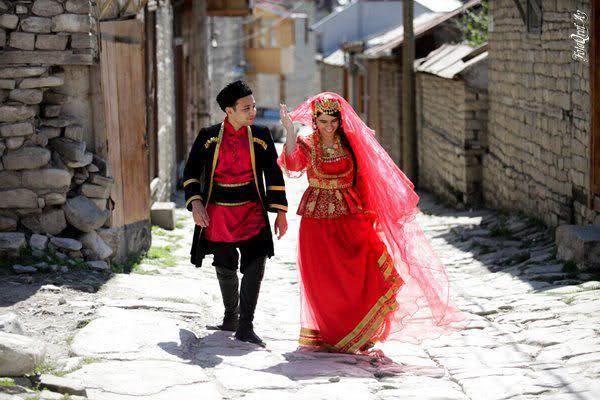
KURDS
The exact origin of the Kurds has not been yet been researched, even though they have an ancient history. The Kurds reside mainly in Kurdestan. It is a large territory extending to a major part of the mountainous region of southeast Turkey, northeast Iraq, northwest Iran and parts of Russia, as well as Syria.
Up until 1914, the Kurds and Kurdestan were divided among Iran, Russia and the Ottoman Empire. Under a treaty concluded between the Soviet Union and Turkey in 1921, the Kurdish-inhabited region of the Caucasus was annexed to the Ottoman Empire. Subsequently, a part of Kurdestan was placed under Iraqi and Syrian rule when the Mosul region was annexed to Iraq.
In Iran, the Kurds mainly reside in Kurdestan, Kermanshahan, and south of the Western Azarbaijan province. In 1600, a number of the Kurds were forced to settle in the north of Khorasan province, at Quchan and Bojnourd, by the Safavid King, Shah Abbas; they still reside there today.
The Kurds are of Iranian origin. Their language is a North-West Iranian language of the Indo-European family of languages and have several dialects. The two Goorani (southern Kurdish) and Zaza (western Kurdish) dialects are vastly different from Kormanji (pure Kurdish). The dialects spoken in Sanandaj, Kermanshahan, and Suleimania (Iraq) are variations of Kormanji. The Kurds' struggle for autonomy and independence dates back to the 19th century, when they were under the Ottoman Empire. Iranian Kurds also rebelled against the central government in 1880.
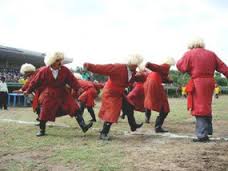
In 1946, the People's Republic of Kurdestan, led by Qazi Mohammad, was established in Iranian Kurdestan, with Mahabad as its capital. The Iranian army crushed the republic when the Red Army pulled out of Iran in the same year.
There are several Kurdish clans. The significant ones are Mokri in the north of Kurdestan, Bani-Ardalan to their south (with Sanandaj as their center), Jaaf in southern and Kalhor in southernmost Kurdestan at the border with Kermanshahan.
Most Kurds are Sunnis of the Shafe'i, and some are followers of Yazidi and Ahl-e Haq sects, but Qaderi and Naqshbandi brands of Sufism are also common in some parts of the Iranian Kurdestan, particularly in its southern regions. The Kurdish population is estimated to be around 1.5 million.
BALUCHIS

The Baluchis reside mainly in Baluchestan, which is a dry region in the south-eastern part of the Iranian plateau. It extends from the Kerman desert to the rest of Bam and Beshagard mountains, and to the western borderline of the Sind and Punjab provinces of Pakistan. Baluchestan is divided between Iran and Pakistan. Iran and Pakistan had a dispute concerning the border dividing the two parts of Baluchestan, which was resolved by an agreement in 1959. The Iranian Baluchestan is a part of the Sistan and Baluchestan province. Its important towns are Zahedan, Zabol, Iranshahr, Saravan, Chahbahar, etc.
Historically, the Baluchis moved to Makran from Kerman to flee an expedition of the Seljuk in the 11th century. At the time, the Baluchis were nomads. They have never had a centralized government and have been living under a tribal system.
Baluch is the title of several tribes, a small number of which live in the Republic of Turkmenistan. The Baluchis speak Baluchi, which is a West Iranian language of the Indo-European family of languages that has been influenced by the eastern Iranian dialects. It has two branches of northern (Sorhadi) and southern (Makrani) Baluchis. The Iranian Baluch tribes are divided into a number of clans. The most important are the Bameri, Balideh, Bozorgzadeh, Riggi, Sardaar Zaie, Shahbakhsh, Lashari, Mobaraki, Mir Morad Zaie, Naroyee, Nooshsiravani, Barohooyee, Baram-Zehi, and Shir-Khanzayee tribes. The Iranian Baluchis are mostly of the Hanafi sect of the Sunni faith.
A few tribes in the Sistan area are also regarded as Baluch, but they speak Sistani. The language is an abandoned dialect of Persian. The notable ones of these tribes are: Sarbandi, Shahraki, Sargazi, Zamir-Farsyoon, Mir-Arab and Sanjarani.
LURS
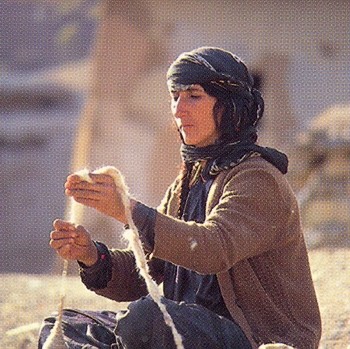
Lur is the title of a group of Iranians living in the mountainous areas of the south-west, mainly in Lurestan province. On the basis of historical evidence, the Lur appear to be of the same ethnic origin as the Kurds.
The Luri language is affixed to the old Iranian language, which suggests the length of time that the Lur have lived in Iran. It is close to Kurdish, but is an independent language in its own right.
There are four main Lur groups: the Bala Garideh, Delfan, Selseleh and Tarhan. The Bala Garideh are the genuine Lur who are divided into important tribes such as Dirakvand, Janaki, Amaleh, Sagvand, etc.
TURKMANS
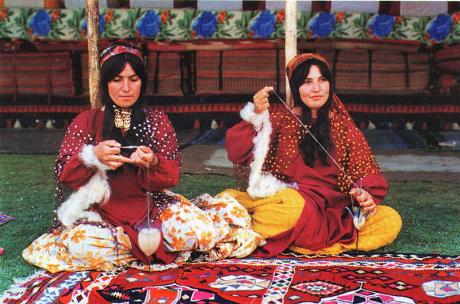
The Turkmans are an ethnic minority who speak the Turkish language with the Eastern Oghoz accent. The same dialect is spoken in the Republic of Turkmenistan. They live in the Turkoman Sahra and in the Gorgan plains. The area is a fertile plain near the Iranian border with the Republic of Turkmenistan. It extends from the Atrak river in the north, to the Caspian Sea in the west, Quchan mountains to the east and the Gorgan river to the south.
Iranian Turkmans have been living in Iran since 550 AD, but they first began forming tribes from 750 AD onwards. They are the descendants of Central Asian Turks, who retained their ethnic identity during the Mongol invasion. They were divided among Iran, Russia and Afghanistan in 1885.
Not all the nine Turkoman tribes live in Iran. The most important Iranian Turkoman tribes are Kuklans and Yamotes. The Kuklans have six branches, and live in the central and eastern Turkoman Sahra. The Yamotes have two large clans, the Atabai and Jaafarbai, and live to the west of Turkoman Sahra. There are also smaller tribes to the east of the region in a few villages.
The Turkoman population is estimated to be around one million, and their biggest towns and cities are Gonbad Kavus, which is the center of Turkoman Sahra, Bandar Turkoman, Aq-Qala, and Gomishan. The largest group of Turkman Muslims follow the Hanafi branch of the Sunni sect, but some Turkmans are followers of the Naqshbandieh sufism.
Turkmans have a history of opposition to central governments. One of their significant rebellions was suppressed by the first Pahlavi king, Reza Shah. That defeat, they believe, struck a deadly blow at their national culture. more on Turkmans
ARABS
Some historians maintain that the first Arabian tribes migrated to Khuzistan, a section in south-west of Iran where they now live, in the early centuries AD, probably moving in from the Arabian peninsula. Arabian tribes are scattered in an areas between the Arvandroud (Shatt al-Arab) and the Persian Gulf in the south and Shush in the north. Their territory is located to the west of the Bakhtiyari territory, and some of them even mingle with the Bakhtiyari tribe. The most important of the Arabian tribes in Iran is the Bani-Kaab, which is also the largest. Its numerous clans inhabit the Minoo Island, Khorramshahr, Shadegan on both sides of the Karun river, up to around Ahwaz to the north. The House of Kassir people are inhabitants of the city of Ahwaz, west and south of Dezful river and between the Dezful and Shushtar rivers.
The Arabians have retained their Arabic language and many of their old customs, but they have lost some of their ethnological characteristics. Information on the size of Arabian population in Iran is not available. One reason for this is the extensive migration of the people from Khuzistan to other parts of Iran following the Iraqi invasion in 1980. The population census taken in 1976 put the size of the Arabian tribal population at around 300,000.
NOMADS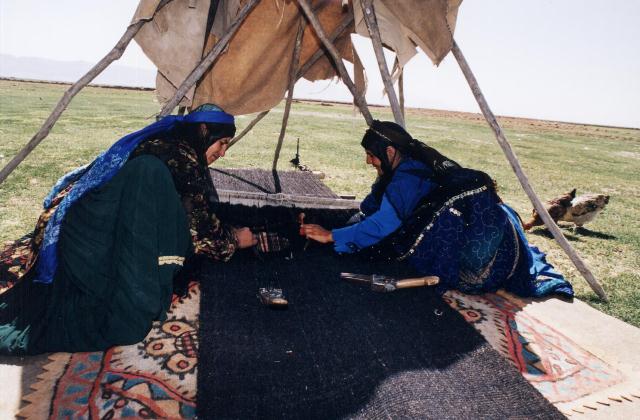
The migrating nomads constitute a community with a way of living distinct from the urban and rural communities. Two major, related factors prompt them to migrate to winter and summer territories, depending on seasonal changes. The first is their livelihood, and the second is the geographical and climatic conditions they live in.
Historically, however, social and political factors have also been influential in creating this pattern of living. These have included political instability, conflicts between local rulers, heavy tax collection campaigns of urban rulers at times of financial problems, etc. The migratory nomads earn their living principally from raising livestock, although farming and handicraft compliment their main occupation. All other economic activities are insignificant.
This compels them to look for fresh grazing lands. Also, the very cold winters in some regions of Iran and extremely hot summers in others force them to move from winter to summer territories and vice versa to avoid the extreme weather conditions.
Over the centuries their communal characteristics have come to take a shape rather different from those of the urban and rural communities. According to the definition the migrating nomads are: a) dependent on livestock raising; b) organized in tribal structure with clear patterns of kinship and relationships; and c) conscious of their tribalism. Furthermore, each tribe has an established territory, with commonly owned grazing lands and with a tribal administrative and social organization.
The nomadic tribes are of several major ethnic origins: Turks, Turkmans, Persians, Kurds, Lurs, Arabs and Baluchis. Hence, they speak a variety of languages and are spread all over the country. Kurdestan and Yazd are the only two provinces without nomadic tribes. But some tribes cross through the latter to get to their winter and summer territories. The Kurdish tribes are in the Bakhtaran province.
Census
The second stage of the latest census taken among the migrating nomads, completed in 1987, showed new results. The total population of nomadic tribes is 1,152,099. There are 597,774 men and 554,325 women. The total number of households is 180,223. The number in the smallest nomadic division, which shall be called the permanent group here for the sake of definition, is 23,606. A permanent group consists of a number of households related either by kinship or by marriage.
The total number of tribes is 96, but there are an additional 547 independent clans. Some of these do have neither a solid tribal structure nor a large number of households. Many of these clans are the remnants of old tribes and clans, which have disintegrated over time or settled in a particular region.
The first stage of the census taken in 1985 had shown that the Kerman and Hormozgan provinces have the highest number of tribes: 28. The largest number of clans, 295 in all, have their territories in the Sistan & Baluchestan and in a part of Khorasan provinces. The highest number of migrating households are in the Chaharmahal & Bakhtiyari, Khuzistan and Isfahan provinces.
Changing patterns
The changing economic, political and social structures in the 20th century have caused certain developments in the related tribal patterns. Two factors influenced the changes in the economic field. These were transactions with sedentary urban and rural communities, and the agrarian reforms of the 1960s and 1970s. The reforms undermined the previous organization of production units. As the result, grazing lands were specified to families.
The application of more advanced agricultural tools and the changing organization of farming reduced the importance of the inter-clan family relations.
The disarming of the nomadic tribes, the increased power of the central government and its intervention in tribal affairs, the promotion of labor markets in the regional towns, the rising rate of literacy, the recruitment by government departments, and the expanding urbanization were all factors that contributed to the changes in the social structure of nomadic population.
Migration was also modernized by expansion of roads and the introduction of cars and motorcycles.
Settlement
Forced settlement of nomadic tribes became a concern of the government under the first Pahlavi king in the 1920s and 1930s. Considering that they had been a source of opposition to central governments in preceding eras, it would have been easier to control them if they settled. Attempts to achieve this were unsuccessful, mainly because they were not accompanied with corresponding measures to provide for the livelihood of nomads.
More attention has been paid to nomadic tribes since the revolution for two reasons. The first is their significant role in livestock raising and meat production, and the second has to do with political problems that could possibly be created by their partial settlement in urban areas. The unfavorable state of grazing lands, the imbroglio concerning ownership of those lands, and the rising prices of commodities that nomads have to procure have initiated a certain tendency towards natural settlement. In the period that elapsed between two tribal censuses in 1974 and 1985, 94,418 nomadic households settled - 89,653 in towns.
QASHQAIE TRIBE
The Turkish speaking Qashqaie tribe is the most reputed tribe in southern Iran. The Qashqaie territory extends from Abadeh and Shahreza in the Isfahan province to the Persian Gulf coast.
The tribe comprises numerous clans. The major ones are Kashkooli, Sheesh Blocki, Khalaj, Farsi Madan, Safi Khani, Rahimi, Bayat, Darreh Shuyee.
One school of thought maintains that the Qashqaies descended from the ancestors of the Turkish Khalaj clan, who lived between India and Sistan region of Iran, and then migrated to central and southern Iran. Each clan has a chief, and there was a general tribal leader who was appointed in the old days. The Qashqaie tribe has never played a decisive role in the national political developments, but it has occasionally been the source of short-lived troubles for the government.
BAKHTIYARI TRIBE
The Bakhtiyari tribe is composed of the clans living in the mountainous regions between the Chaharmahal, Fars, Khuzistan (the Taftoon Field), and Lurestan provinces.
The tribe is divided into two separate branches: Haft Gang and Chahar Gang. The former consists of 55 and the latter of 24 clans. The Arabian and Lur clans mix together in the Bakhtiari tribe. The Bakhtiari tribe is also called the Great Lur. Scholars have differing opinions on its origin. However, the opinion mostly adhered to and more extensively documented maintains the Bakhtiaris are of Kurdish origin. The Bakhtiari overlords have been influential in political developments since the era of the Safavids and the Nader Shah. Some of their leaders helped constitutional revolutionaries conquer Tehran during the Period of Minor Despotism. That was when the Qajar king, Mohammad Ali Shah, suspended the parliament and the constitution in 1907.